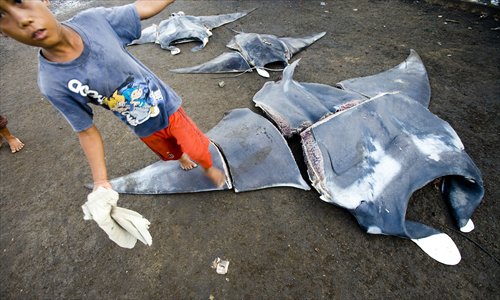Extinction in a bottle

Last week, an Australian satirical show called The Checkout was sued for defamation by Professor Avni Sali on behalf of Swisse, a herbal supplement company headed up by his son Radek. No doubt the brand name was the brain child of a clever marketing analyst who assumed consumers would equate Swisse with alpine clinics, legitimacy and cool refined doctors. Maybe even a singing nun.
The product lampooned was advertised as an appetite suppressant. For many reasons to do with the culture of modernity, popping a pill is more desirable than guaranteed methods - changing eating patterns and taking regular exercise.
Some say it would have been better if the good professor had shut up and not drawn attention to what is wrong in Australian alternative medicine. That warning could be widened to include all of Asia.
Falling prey
Many Australians are easily swayed by dubious promises of packaged health benefits.
Most detox products based on plants are in themselves harmless. Expensive, useless and illusory yes, but harmless. The exception is manta ray gill plates. Marketed as a way of reducing body heat and purifying the body, the newly created appetite for gill plates is one of the most egregious example of the new wave of fake medicines that is threatening to wipe out this amazing species.
Chinese people are being taken for a ride on a train that threatens the existence of one of the ocean's iconic species, the manta ray.
Some traditional Chinese medicine (TCM) shops sell manta and mobula gill rakes, claiming they withdraw "poison" from the blood and clear away "body heat" at a significant cost to customers.
But in reality it's the marine ecology that pays. At the current rate of hunting, manta and mobula rays may soon cease to exist.
The current avian flu outbreak is sure to increase the demand for manta gills rakes, following advertising that gills boost the body's immune system. "But it has no real medicinal value," TCM practitioner Dr Chun Hung told Al Jazeera recently.
He agreed that gills are not listed in any TCM text and their benefits are mere hearsay. Chun, a university lecturer, is concerned that the preparation methods may actually cause disease, and warns against self-medication, reliance on which may induce a false sense of security.
Costly to detox
Detox diets and the expanding market in fake medicine also irritate Washington University nutrition director, Connie Diekman.
"Detox diets prey on the vulnerability of dieters with fear tactics while gaining financially by selling products that are not necessary and potentially dangerous," she told Web MD. Detoxification is a specialist treatment for alcoholism, drug addiction and heavy metal contamination; and is heavily supervised.
Eion Meades, a TCM practitioner in Brisbane, said "there are lots of stupid claims. It's like you can eat rhino horn, which is after all only compressed hair, and feel well. Rhinos are also known to have poor sight and bad tempers. Does the consumer who eats rhino horn want poor sight or grumpiness? I think TCM is fabulous, but some charlatans bring TCM into disrepute."
Consumers may need to know that mantas cannot reverse, are friendly and are always on the move to trap and extract much needed oxygen, not poisons, from the sea. In tourist dollars globally they are worth far more than $65-100 million. But the private profits made from gills are huge. It is estimated that the trade is worth $11.3 million per year.
"It's extinction in a bottle," said Shawn Heirichs, a conservation cinematographer who has been researching the trade for Manta Ray of Hope.
"Hong Kong traders have created a trade in manta gills to replace shark fin losses." Heinrichs posited.
"When it comes to commerce it's no holds barred," he said. "The scale of the demand from China is so huge and control is almost impossible. What is worse is that this killing for money culture is being spread in places like Lamakera in eastern Indonesia, where officials are scared of the fishermen gangs. I heard of a father who had retaliated after a curse on his sons. He decapitated those he thought guilty."
Hefty price tag
Heinrich's colleagues found that the fishermen get around $40 per kilogram for the gills, but by the time these get to the local Chinese trader, the price has increased to $100 per kilogram. Upon arrival in China, the price has doubled again.
A medium manta ray can yield five kilograms of dried gills. A decade ago, Chinese shark fin traders established trade relations with communities in Sri Lanka and Eastern Indonesia among other places, supplying diesel engines, fuel and gear to increase the catch. Now all this is being used to catch mantas.
According to the Pew Charitable Trusts, a Philadelphia-based NGO, Chinese city of Guangzhou takes up as much as 99 percent of a global market that includes Hong Kong and Southeast Asia. Market analysis suggests the total annual gill trade ranges between 60,000 and 80,000 kilograms per annum. Female rays may only produce two to three young during their lives and a snowball effect could soon be catastrophic. Al Jazeera showed an old TCM vendor insisting that the oceans are vast and the species is not in trouble. He is wrong.
At the current rate of fishing manta rays are in danger. There are moves to list them under the Convention on the International Trade in Endangered Species. But if Heinrichs is right, and the trade is led by the superrich, it will be hard to enforce unless there is a massive consumer backlash.
"Only China can reverse this trend," concluded Heinrichs.